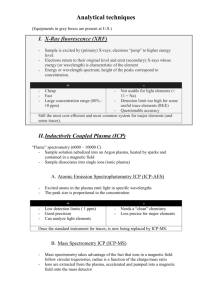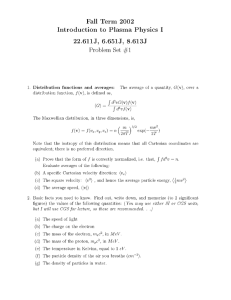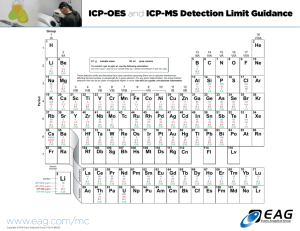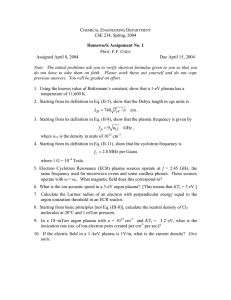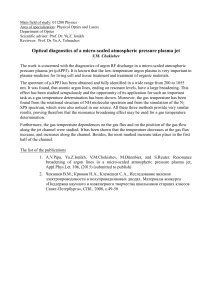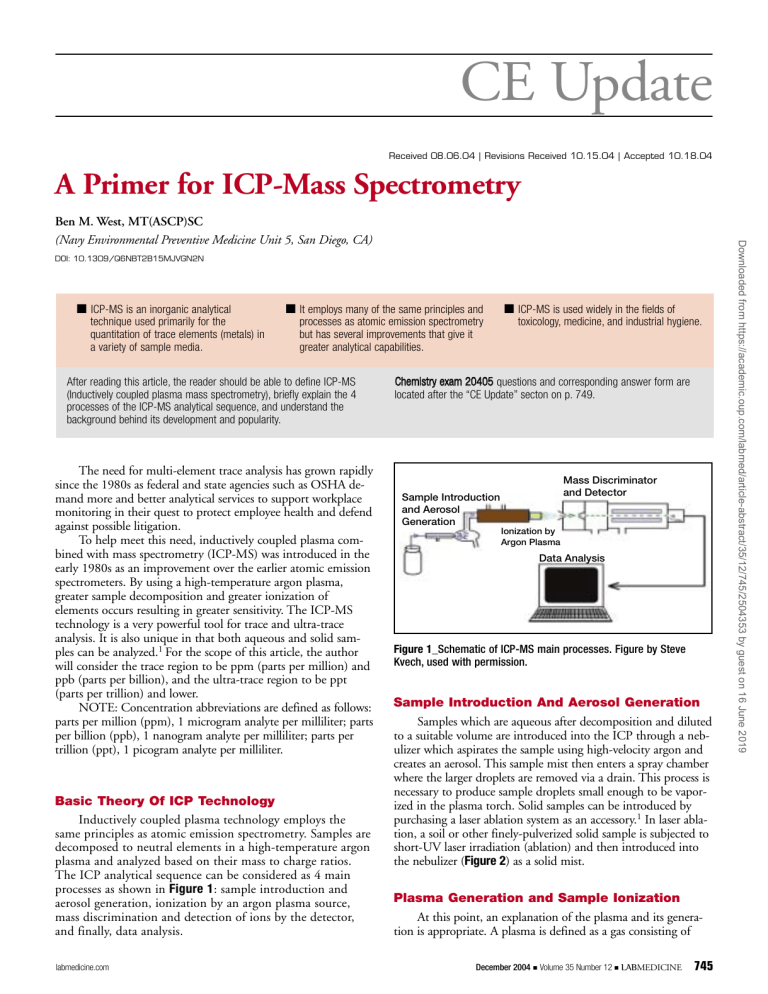
CE Update Received 08.06.04 | Revisions Received 10.15.04 | Accepted 10.18.04 A Primer for ICP-Mass Spectrometry DOI: 10.1309/Q6NBT2B15MJVGN2N ICP-MS is an inorganic analytical technique used primarily for the quantitation of trace elements (metals) in a variety of sample media. It employs many of the same principles and processes as atomic emission spectrometry but has several improvements that give it greater analytical capabilities. After reading this article, the reader should be able to define ICP-MS (Inductively coupled plasma mass spectrometry), briefly explain the 4 processes of the ICP-MS analytical sequence, and understand the background behind its development and popularity. The need for multi-element trace analysis has grown rapidly since the 1980s as federal and state agencies such as OSHA demand more and better analytical services to support workplace monitoring in their quest to protect employee health and defend against possible litigation. To help meet this need, inductively coupled plasma combined with mass spectrometry (ICP-MS) was introduced in the early 1980s as an improvement over the earlier atomic emission spectrometers. By using a high-temperature argon plasma, greater sample decomposition and greater ionization of elements occurs resulting in greater sensitivity. The ICP-MS technology is a very powerful tool for trace and ultra-trace analysis. It is also unique in that both aqueous and solid samples can be analyzed.1 For the scope of this article, the author will consider the trace region to be ppm (parts per million) and ppb (parts per billion), and the ultra-trace region to be ppt (parts per trillion) and lower. NOTE: Concentration abbreviations are defined as follows: parts per million (ppm), 1 microgram analyte per milliliter; parts per billion (ppb), 1 nanogram analyte per milliliter; parts per trillion (ppt), 1 picogram analyte per milliliter. Basic Theory Of ICP Technology Inductively coupled plasma technology employs the same principles as atomic emission spectrometry. Samples are decomposed to neutral elements in a high-temperature argon plasma and analyzed based on their mass to charge ratios. The ICP analytical sequence can be considered as 4 main processes as shown in Figure 1: sample introduction and aerosol generation, ionization by an argon plasma source, mass discrimination and detection of ions by the detector, and finally, data analysis. labmedicine.com ICP-MS is used widely in the fields of toxicology, medicine, and industrial hygiene. Chemistry exam 20405 questions and corresponding answer form are located after the “CE Update” secton on p. 749. Mass Discriminator and Detector Sample Introduction and Aerosol Generation Ionization by Argon Plasma Data Analysis Figure 1_Schematic of ICP-MS main processes. Figure by Steve Kvech, used with permission. Sample Introduction And Aerosol Generation Samples which are aqueous after decomposition and diluted to a suitable volume are introduced into the ICP through a nebulizer which aspirates the sample using high-velocity argon and creates an aerosol. This sample mist then enters a spray chamber where the larger droplets are removed via a drain. This process is necessary to produce sample droplets small enough to be vaporized in the plasma torch. Solid samples can be introduced by purchasing a laser ablation system as an accessory.1 In laser ablation, a soil or other finely-pulverized solid sample is subjected to short-UV laser irradiation (ablation) and then introduced into the nebulizer (Figure 2) as a solid mist. Plasma Generation and Sample Ionization At this point, an explanation of the plasma and its generation is appropriate. A plasma is defined as a gas consisting of December 2004 Volume 35 Number 12 LABMEDICINE 745 Downloaded from https://academic.oup.com/labmed/article-abstract/35/12/745/2504353 by guest on 16 June 2019 Ben M. West, MT(ASCP)SC (Navy Environmental Preventive Medicine Unit 5, San Diego, CA) CE Update Detector Quadrupole Rods Sample Vacuum Chamber Argon gas Figure 3_Quadrupole mass filter. Figure by Steve Kvech, used with permission. ions, electrons, and neutral particles. In ICP-MS, the plasma is formed when argon is subjected to an intense magnetic field provided by a radio frequency (RF) signal fed into a tightly wound, water-cooled coil. Argon passes into a glass or quartz torch, which is surrounded by the coil to which the RF signal is applied. With the argon flowing, the RF signal is applied creating a magnetic field which ionizes the argon. A spark from a Tesla unit (much like a car spark plug) causes this highly ionized and now energized mixture to “light” causing the bright white plasma flame. The plasma is maintained as long as the magnetic field and argon flow continue uninterrupted. The temperature of the plasma is quite high, reaching about 7,000 degrees Kelvin.2 Now, let us look at what happens to a sample when it is subjected to the plasma. Once the sample passes through the nebulizer and partial solvent removal (desolvation) has occurred, the sample moves into the plasma torch where it is mixed with the constantly flowing argon. The plasma removes any remaining solvent and causes atomization of the sample followed by ionization. In addition to being ionized, these sample ions are excited in the hot plasma, the same phenomenon used in ICP atomic emission spectrometry.1 for) are allowed to reach the detector. As shown in Figure 3, a quadrupole mass filter is made of 4 metal rods aligned in a parallel diamond pattern. A combined DC and AC electrical potential is applied to the rods with opposite rods having a net negative or positive potential. Ions enter into the path between all of the rods. When the DC and AC voltages are set to certain values, only 1 particular ion is able to continue on the path between the rods and others are forced out of the path. This 1 ion will have a specific m/z ratio. Various combinations of voltages are chosen which allows an array of different m/z ratio ions to be detected. While the quadrupole arrangement is most commonly used, other types of mass filters are available such as double-focusing magnetic-sector, time of flight, and collision/reactor cell. After ion separation occurs, the chosen ions pass through a small opening to the detector.1 The ICP-MS Interface Once the ions are produced in the plasma, they are directed into the mass spectrometer via the interface region which is maintained at a vacuum of about 1 to 2 torr by a mechanical pump. The interface region consists of 2 cones (usually nickel) called the sample and the skimmer. Each cone has a small (0.6 to 1.2 mm) orifice to allow the ions to pass through to the ion optics (electrostatic lenses) where they are guided into the mass separation device—the heart of the mass spectrometer. It is the job of the ion optics to focus the ion beam formed in the cones and containing both analyte and matrix ions into the mass separation device. The ion optics also serve the purpose of preventing stray photons, particulates, and neutral species from eventually reaching the detector.3 The Mass Spectrometer (MS) Once the ions have entered the mass spectrometer, they are separated according to their mass-to-charge (m/z) ratio in the quadrupole mass filter and only those ions selected (analyzed 746 LABMEDICINE Volume 35 Number 12 December 2004 The Detector In the detector, the ions are converted into electrons thereby creating an electrical signal, which can be recorded and converted into a concentration reading using a calibration graph. The most common type of detector used in an ICP-MS system is the channeltron electron multiplier. This is a cone or hornshaped tube which has a high voltage applied to it and is opposite to the charge of the ions being detected. As the ions leave the quadrupole mass filter, they are attracted to the interior cone surface. As the ions strike the surface, additional secondary electrons are emitted which move farther into the tube emitting additional secondary electrons. As this process continues, even more electrons are formed, resulting in as many as 108 electrons at the other end of the cone.1 Data Analysis Data generated by the ICP-MS can be either quantitative or semi-quantitative. In most federal and state government laboratories, methodologies for industrial hygiene and environmental analysis such as NIOSH and OSHA require quantitative data based on at least 3 calibration points plus a verification of the resulting calibration curve by an outside standard purchased from a commercial source. The final reported results are calculated in parts per million (ppm) or parts per billion (ppb). Semiquantitative data, which is often based on a 1-point calibration curve, is very useful in screening unknown samples suspected of labmedicine.com Downloaded from https://academic.oup.com/labmed/article-abstract/35/12/745/2504353 by guest on 16 June 2019 Figure 2_Generation of aerosol by nebulizer. Figure by Jenna Worley, used with permission. CE Update having high concentrations of the analyte of interest prior to dilution for quantitative analysis. labmedicine.com 1. Worley J, Kvech S. ICP-MS Web page, graduate project, Department of Civil Engineering, Virginia Polytechnic Institute. Blacksburg, Virginia. 2. Glascock MD, Speakman J. ICP-MS at MURR (University of MissouriColumbia) Archaeometry Laboratory. Available at: www.missouri.edu. Accessed October 18, 2004. Downloaded from https://academic.oup.com/labmed/article-abstract/35/12/745/2504353 by guest on 16 June 2019 Summary ICP-Mass Spectrometry is a highly popular choice for multi-element trace analysis in fields such as toxicology, environmental chemistry, and industrial hygiene chemistry. Additionally, laboratories that offer environmental and industrial hygiene testing, which use federally-mandated methods such as OSHA and NIOSH, are required to provide ever-lower limits of quantitation for environmental contaminants such as cadmium and lead and to operate in an increasingly litigious environment. As shown in the article, an ICP-MS instrument has many of the same components and uses the same physical processes as the earlier mass spectrometers. However, by adding a hightemperature plasma and adapting the sample intake system to accommodate both liquid and solid samples give the ICP-MS greater sensitivity and versatility. Finally, while ICP technology may seem complicated and intimidating to a new user, its theory and operation are well within the technical training and education of most generalist medical technologists and certainly those with an interest in chemistry and toxicology. LM 3. A guide to inductively coupled plasma mass spectrometry. Spectroscopy Magazine, Eugene, OR. Special Project Supplement. Poster by Scientific Solutions. December 2004 Volume 35 Number 12 LABMEDICINE 747
